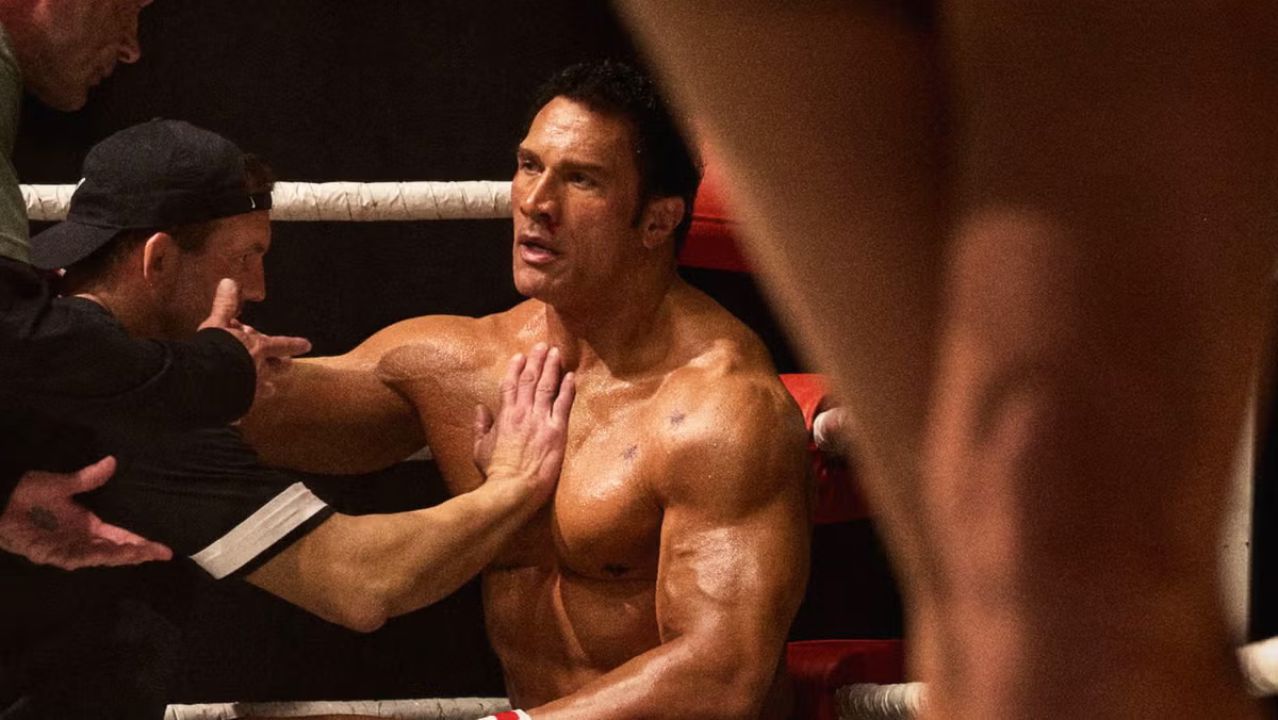The Smashing Machine (2025): Dwayne Johnson’s Gritty Sports Drama Redefines Triumph and Turmoil
The world of combat sports is no stranger to pain, glory, and redemption—but few films dare to capture the human spirit behind the bruises quite like The Smashing Machine. Directed by Benny Safdie, the visionary half of the Safdie Brothers duo, this sports drama brings raw authenticity to the screen with powerhouse performances from Dwayne “The Rock” Johnson, Emily Blunt, and Ryan Bader.
Set to release in theaters on October 10, 2025, The Smashing Machine dives deep into the emotional, physical, and psychological toll of being an MMA fighter at the peak of fame yet the edge of collapse. Based on real-life inspirations and fueled by Safdie’s distinctive filmmaking style, this is one of 2025’s most anticipated releases—where sports meet soul.
The Smashing Machine: Key Details
- Genre: Sports | Drama | Biographical
- Director: Benny Safdie
- Cast: Dwayne Johnson, Emily Blunt, Ryan Bader
- Music: Nala Sinephro
- Cinematography: Maceo Bishop
- Producers: Benny Safdie, Dwayne Johnson, Eli Bush, Hiram Garcia, Dany Garcia, David Koplan
- Release Date: October 10, 2025
- Rating: U/A (India) | PG-13 (USA Expected)
- Runtime: Approx. 2 hours 15 minutes
- Language: English
The Smashing Machine Story: Between the Ring and Redemption
At its core, The Smashing Machine is a story about Mark Kerr, a legendary mixed martial arts (MMA) fighter whose professional victories contrast sharply with his internal struggles. Inspired by the real-life fighter of the same name, the film presents a deeply human look at addiction, fame, love, and identity.
Dwayne Johnson, known globally for his charisma and physical prowess, steps into one of his most emotionally demanding roles yet. Instead of portraying a superheroic figure, Johnson embodies a broken man—one torn between personal demons and public expectations.
Plot Overview (Spoiler-Free)
The film opens with Kerr at the height of his career—a dominant force in the cage, nicknamed “The Smashing Machine” for his ferocious fighting style. But behind the muscles and medals lies a fragile psyche haunted by insecurity, dependence on painkillers, and the pressure to stay on top.
Emily Blunt plays Dawn Staples, Kerr’s partner and emotional anchor. Her character offers both warmth and realism as she stands by a man fighting not just opponents, but himself. Meanwhile, Ryan Bader plays Kerr’s rival and training partner, blurring the line between competition and camaraderie.
As the film progresses, we see a brutal yet heartfelt portrait of what it takes to survive in a sport that celebrates destruction as much as discipline. It’s about more than victory—it’s about finding meaning when the applause fades.
A Director’s Vision: Benny Safdie’s Raw Realism
Known for his work on Uncut Gems and Good Time, Benny Safdie brings his trademark intensity to The Smashing Machine. His direction is visceral and immersive—viewers feel every punch, every gasp, and every heartbeat inside the octagon.
Safdie’s filmmaking style thrives on chaos and emotional honesty. He doesn’t glamorize fame or violence. Instead, he exposes their consequences, presenting a deeply human story of vulnerability wrapped in adrenaline.
His decision to cast Dwayne Johnson, one of Hollywood’s biggest stars, in such a gritty and self-destructive role showcases both bold casting and creative ambition. Safdie turns “The Rock” into a symbol of fragility—a man who’s strong enough to destroy others but too weak to save himself.
Cinematography: The Art of Sweat and Shadows
The film’s visual storytelling is handled by Maceo Bishop, whose lens captures both the physicality of combat and the emotional stillness that follows. The camera stays close, almost claustrophobically intimate, allowing the audience to feel the intensity of every fight.
The lighting is raw—harsh during matches, soft during personal moments—reflecting Kerr’s dual existence between public spectacle and private suffering. Bishop’s work makes the film feel like a documentary at times, grounding even the most dramatic scenes in realism.
Music and Soundtrack: A Pulse of Pain and Power
The soul of The Smashing Machine lies in its soundscape. Nala Sinephro, known for her ethereal and experimental compositions, crafts a haunting yet hopeful score. Instead of traditional high-tempo sports anthems, the soundtrack blends ambient jazz, electronic tones, and percussive heartbeats—mirroring the internal rhythm of a fighter’s fear and focus.
The music doesn’t just accompany the film; it narrates it. Each note feels like an emotional echo of Kerr’s mind—a melody of isolation, resilience, and redemption.
Performances That Power the Film
Dwayne Johnson as Mark Kerr
This is not the Dwayne Johnson audiences are used to. Gone are the witty one-liners and superhero bravado. In The Smashing Machine, Johnson delivers a career-defining performance—a raw, emotional portrayal of a man battling inner darkness.
He gained significant weight and trained with real MMA fighters to embody Kerr’s physical and emotional state authentically. His nuanced performance captures the dichotomy of strength and vulnerability, making it one of his most mature roles to date.
Emily Blunt as Dawn Staples
Emily Blunt brings grace, empathy, and quiet strength to the film. Her chemistry with Johnson anchors the narrative emotionally. Blunt’s portrayal of Dawn reflects the silent endurance of those who love someone self-destructing in slow motion.
Ryan Bader as Himself (Rival Fighter)
Professional fighter Ryan Bader plays a fictionalized version of himself—a rival and reluctant ally. His inclusion lends authenticity to the fight choreography and locker-room dynamics, grounding the film’s sports realism.
Together, this trio delivers performances that elevate the script beyond a simple sports drama—it becomes a study of human endurance and emotional truth.
Themes That Hit Hard
1. The Price of Greatness
The film examines how the pursuit of perfection often destroys the very people who achieve it. Kerr’s body wins battles his mind keeps losing.
2. Addiction and Identity
Addiction, both to painkillers and validation, forms the movie’s emotional spine. Aronofsky-style intensity meets Safdie-style realism as the film portrays addiction not as a flaw, but as a desperate search for control.
3. Love as Survival
Emily Blunt’s character symbolizes how love becomes both salvation and struggle. Her presence reflects the resilience of relationships tested by fame, ego, and fear.
4. Reality vs. Persona
The Smashing Machine explores how athletes are forced to maintain public images that don’t reflect their truth. Dwayne Johnson’s transformation into Kerr mirrors the actor’s own subversion of his real-life persona—turning invincibility into fragility.
Visual Storytelling: Inside and Outside the Cage
Every fight in The Smashing Machine feels like a cinematic event. Safdie and Bishop make the audience experience combat from inside the octagon, using dynamic camera movements and long takes that build tension without resorting to cinematic tricks.
The fight scenes aren’t about winning—they’re about surviving. Sweat, blood, and exhaustion are captured with such authenticity that viewers can feel the physical toll of every strike.
Outside the ring, quiet moments—Mark sitting in silence, Dawn watching him from afar, or a close-up of hands trembling before a match—reveal more pain than the fights themselves. It’s this juxtaposition that makes The Smashing Machine a masterpiece of emotional storytelling.
Production and Behind-the-Scenes Insight
The movie was shot across real gyms, arenas, and urban neighborhoods in New York and Nevada, giving it a tangible sense of authenticity. Dwayne Johnson worked closely with MMA legends and trained under professionals to capture the sport’s technicality.
Benny Safdie’s direction demanded emotional vulnerability from his actors, often using long takes to capture spontaneous reactions. This unfiltered approach mirrors the documentary that inspired the film—the 2002 HBO piece The Smashing Machine: The Life and Times of Mark Kerr.
Why The Smashing Machine Stands Out in 2025
With so many biopics and sports dramas released every year, The Smashing Machine breaks the mold. Here’s why it stands apart:
- Dwayne Johnson in a never-seen-before dramatic role
- Benny Safdie’s bold, intimate filmmaking style
- A balance between realism, heart, and psychological depth
- Emotional storytelling over traditional sports triumph tropes
- An atmospheric, soul-stirring score by Nala Sinephro
This isn’t just a movie about fighting—it’s about falling and finding strength in imperfection.
Box Office & OTT Expectations
Given its emotional appeal and global fan base, The Smashing Machine is expected to be a box office success. With Johnson’s star power and Safdie’s critical acclaim, early projections suggest strong domestic and international openings.
OTT Platform & Release
While the official OTT partner is yet to be announced, The Smashing Machine is likely to stream on Amazon Prime Video or Netflix by early 2026, following its theatrical run.
FAQs About The Smashing Machine (2025)
Q1. When is The Smashing Machine releasing?
The film will hit theaters worldwide on October 10, 2025.
Q2. Who stars in The Smashing Machine?
The movie stars Dwayne Johnson, Emily Blunt, and Ryan Bader.
Q3. Who directed the film?
It is directed by Benny Safdie, known for Uncut Gems and Good Time.
Q4. What genre is The Smashing Machine?
It’s a sports drama infused with biographical and emotional realism.
Q5. Who composed the music?
The film’s soulful score is composed by Nala Sinephro.
Q6. What is The Smashing Machine based on?
It’s inspired by the real-life story of MMA legend Mark Kerr, exploring his rise, struggles, and redemption.
Review (Early Outlook): Raw, Emotional, and Unforgettable
Early reactions from private screenings suggest that The Smashing Machine might be Dwayne Johnson’s best performance yet. Critics praise the movie for its honesty, restraint, and authenticity.
Benny Safdie’s direction transforms the typical sports biopic into an emotional odyssey. It’s gritty, heart-wrenching, and beautifully tragic—proving that true strength isn’t found in punches, but in perseverance.
Expect The Smashing Machine to dominate the 2025 awards circuit for Best Actor, Best Director, and Best Cinematography.
Conclusion
The Smashing Machine (2025) is not just a sports film—it’s a soul-stirring journey about fighting life’s toughest opponent: yourself. Through Safdie’s unfiltered direction and Dwayne Johnson’s transformative performance, it explores fame, fear, and forgiveness with haunting realism.
When it hits theaters on October 10, 2025, this movie will not only entertain but inspire—reminding audiences that the hardest battles are fought within.
Disclaimer
This article is based on pre-release information, interviews, and official announcements available at the time of writing. Final storylines, runtime, and box office details may change upon theatrical release.
Read Also:

